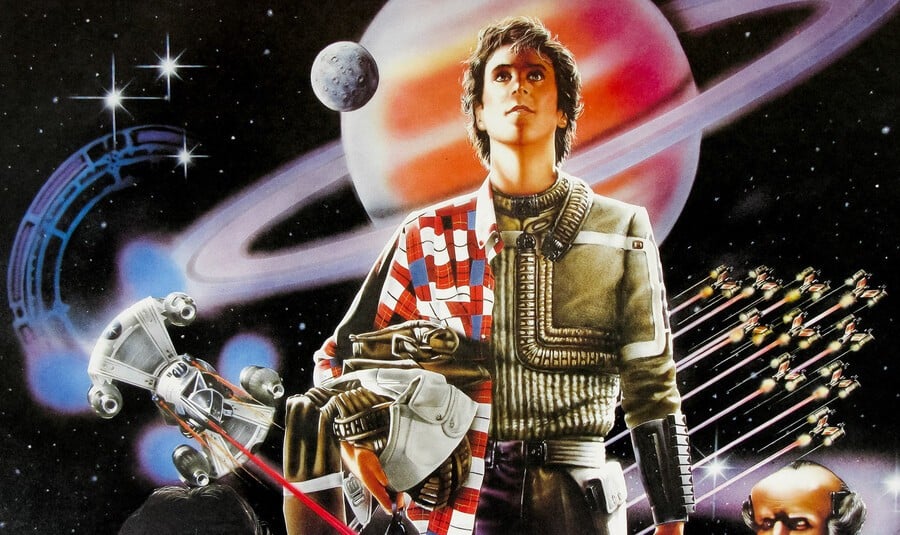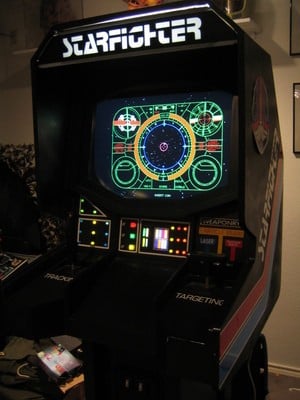
Released July 1984 in US cinemas, The Last Starfighter tells the story of Earth teenager Alex Rogan, recruited by the Star League as a combat pilot after breaking the record in the (fictional) Starfighter arcade game. Although reminiscent of Star Wars, the film was notable for its CGI and its very slick-looking but fake video game. This would capture the interest of gamers for decades to come, much like the fake "Ice Cave" game from the 1988 Tom Hanks film Big. Interestingly, there were multiple attempts at making a game based on The Last Starfighter, at least four of which were rebranded or cancelled outright.
From the start, Atari was planning a tie-in arcade game; screenshots and a promotional video were made, and a proposal document was written, but the game was cancelled due to immense cost. System16 cites the Atari System IV hardware. Retroarcade1 had a detailed article citing the project's members and Atari's desire to create a 3D polygonal arcade system. The website is currently dead, but the article can be accessed via the Wayback Archive.
What happened next was at least three attempts at adapting the film for home systems, all of which ended up rebranded as something else.
The least well-known of these is Final Justice for the MSX by Compile. Speaking in an interview in 2013 for The Untold History of Japanese Game Developers, former staff members Satoshi Fujishima and Takayuki Hirono described what happened. Fujishima is perhaps best known for creating action-RPG Golvellius, while Hirono helped create and define the Aleste series. It was a long day, and this was just one of several surprising revelations...
John Szczepaniak: Mr Fujishima, you made Final Justice on MSX. Recently it sold for 70,000 yen on auction. (Roughly £380 at that time)
Satoshi Fujishima: That's a lot! <laughs> I programmed it, composed the sound, and did the graphic design. I have one copy of the cartridge, but not the packaging.
Takayuki Hirono: It was probably a very small print run.
Satoshi Fujishima: It must have been!
Takayuki Hirono: At the time there was some talk from Pony Canyon about making a licensed game for the movie The Last Starfighter, but they never ended up getting the license. But the game was already underway, so we just finished it up and released it under the name Final Justice.

This news was incredible. There was a lot of crosstalk in the interview and a lot of debate on various topics. We needed to be sure we understood this correctly, so reiterated the statement: the film The Last Starfighter came out, there were plans to make a game, programming started, the license fell through, and the code was reworked into Final Justice on MSX?
All the Compile staff nodded in agreement - that is what happened.
Fujishima then added:
The original plan was to base the game on the film, so they gave us a videotape of the as-yet unreleased movie, The Last Starfighter. Well, it hadn't been released in Japanese theatres at that point. I think it was subtitled. I would not have understood it otherwise! <laughs>
IMDb gives the Japanese release date for the film as April 1985, while Generation-MSX gives August 1985 as the release date for Final Justice. The game itself was forgettable; although quite smooth, it was very basic and repetitive. Only its legacy as a failed film adaptation makes it noteworthy today. Given the rarity and cost of Final Justice, it's unsurprising to find fans online posting photos of their pristine copies.
Other failed attempts to adapt the film include for the Atari 2600, 5200, and 400/800 systems. AtariProtos examines the 2600 and 5200 versions in detail. A game called Universe was being made for the 2600 by Doug Neubauer, it was reworked into The Last Starfighter and later became Solaris (1986). A game called Orbiter was 35% done before being rebranded The Last Starfighter, and then rebranded again as Star Raiders II for Atari XL and XE (1986-87), then ported to 8-bit micros. All were fantastic on their own merits. Prototype ROMs of the Atari versions can be found online.
That makes for four failed attempts (arcade, MSX, 2600, and 5200). The only officially branded and actually released game was for the NES, developed by Graftgold and published by Mindscape in June 1990. This, however, is simply a reskin of Andrew Braybrook's original Uridium for the Commodore 64 from 1986, and not an original adaptation of the movie – which is a shame.

The cancellations of the Atari versions are attributed to costs, less than spectacular reception of the film, and Atari's struggles during the video game crash. But it's unknown why Pony Canyon lost the deal. Since 1983 they'd been licensing best-selling games from abroad; were deeply involved in movies, music, and TV; and were about to branch into movie/game tie-ins.
One was the excellent Mashou no Yakata Gabarin for MSX1 (1987), based on the 1985 American horror/comedy movie House. (There's speculation that Dr. Chaos on the NES, which was published in Japan by Pony Canyon, was also originally meant to be an adaptation of the movie House.) Pony Canyon was no stranger to film licenses, but sometimes deals fall through, as happened with The Last Starfighter.
In 2007 a freeware "interpretation" of the game from the film was released by Rogue Synapse for PC, which they also placed inside an arcade cabinet acquired from a documentary on the original film.
As for the movie itself, it became something of a cult classic on VHS following a less-than-spectacular cinematic run. Since 2008, there have been rumours that a sequel would be made, and in 2021, screenwriter (and former games journalist) Gary Whitta posted a concept reel for a possible follow-up.
Did you watch the film and dream of playing the same game Alex Rogan played? Did you play the official NES release and feel a little disappointed that it was merely a reskinned game? Or maybe you played one of the other failed attempts that were then reskinned? Of all the games which attempted to live up to the film, which do you feel came closest? Let us know with a comment below.
